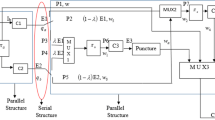Abstract
In this paper, performance of reduced state space-time trellis coded multi carrier code division multiple access (STTC-MC-CDMA) system is evaluated and compared with the performance of original state STTC-MC-CDMA system. The optimum decoding scheme, i.e., maximum likelihood sequence estimation is employed which uses Viterbi algorithm for decoding STTC code. To simplify the implementation of the STTC decoder, the number of states is reduced by reducing the constraint length of the STTC encoder using generating function technique. In this technique, the generator matrix of STTC code is minimized to reduce the number of states of S–T trellis decoder. It is observed that the performance loss in terms of frame error rate of the reduced state STTC-MC-CDMA system is negligible compared to the original state STTC-MC-CDMA system. It is also noted that by using the reduced state technique the STTC decoder can be made faster since it is having lower computational complexity.









Similar content being viewed by others
References
Tarokh, V., Seshadri, N., & Calderbank, A. R. (1998). Space-time codes for high data rate wireless communication: Performance criterion and code construction. IEEE Transactions on Information Theory, 44(2), 744–765.
Liu, M., Helard, J. F., Crussiere, M., & Helard, M. (2013). Reduced complexity maximum-likelihood decoding for 3D MIMO code. In Proceedings of the IEEE WCNC (pp. 4015–4020).
Wesel, R. D. (2004). Reduced-state representations for trellis codes using constellation symmetry. IEEE Transactions on Communications, 52(8), 1302–1310.
Bansal, L. K., & Trivedi, A. (2008). Performance study of space-time trellis coded MC-CDMA system employing different detection techniques. In Proceeding of the IEEE WCSN (pp. 137–140).
Sheen, W.-H., & Stuber, G. L. (1992). Error probability for reduced state sequence estimation. IEEE Journal on Selected Areas in Communications, 10(3), 571–578.
Nago, T. M. H., Zaharia, G., Bougeard, S., & Helard, J. F. (2007). 4-PSK balanced STTC with two transmit antennas. In Proceedings of the IEEE VTC (pp. 1693–1697).
Wu, Y., Lau, V. K. N., & Patzold, M. (2006). Constellation design for trellis-coded unitary space-time modulation systems. IEEE Transactions on Communications, 54(11), 1948–1959.
Souza, R. D., Pimentel, C., & Muniz, D. N. (2012). Reduced complexity decoding of convolutional codes based on the M-algorithm and the minimal trellis. Springer’s Annals of Telecommunications, 67(11–12), 537–545.
He, R., & Cruz, J. R. (1999). A reduced-state sequence estimation technique and its applications. IEEE Transactions on Magnetics, 35(5), 2331–2333.
Turner, J., & Taylor, D. P. (2009). Reduced complexity decoding of space time trellis codes in the frequency selective channel. IEEE Transactions on Communications, 57(3), 635–640.
Viland, P., Zaharia, G., & Helard, J. F. (2011). Optimal generation of space-time trellis codes via coset partitioning. IEEE Transactions on Vehicular Technology, 60(3), 966–980.
Sourour, E. A., & Nakagawa, M. (1996). Performance of orthogonal multicarrier CDMA in a multipath fading channel. IEEE Transactions on Communications, 44(3), 356–366.
Sun, W., Li, H., & Amin, M. (2003). MMSE detection for space-time coded MC-CDMA. In Proceedings of the IEEE (pp. 3452–3456).
Ostuni, F. S., Nakhai, M. R., & Aghvami, H. (2003). Iterative multi-user MMSE receiver for space-time trellis coded CDMA systems over frequency selective channels. In Proceedings of the IEEE ISPIMRC’14 (pp. 703–707).
Dai, X., Sun, S., & Wang, Y. (2012). Reduced complexity (Quasi-) maximum-likelihood detectors with no performance degradation for S-QAM modulated MIMO systems. Springer’s Wireless Personal Communication, 66(4), 613–627.
Bansal, L. K., Trivedi, A., & Gupta, R. (2012). Performance evaluation of downlink space-time coded MC-CDMA systems in presence of channel estimation. Communications of ACTA-Press, 1, 1–7.
Akay, E., & Ayanoglu, E. (2006). Achieving full frequency and space diversity in wireless systems via BICM, OFDM, STBC, and Viterbi decoding. IEEE Transactions on Communications, 54(12), 2164–2172.
Trivedi, A., & Bansal, M. (2007). Adaptive equalization of space-time coded MC-CDMA systems. In Proceedings of the IEEE PACRIM’07 (pp. 186–189).
Author information
Authors and Affiliations
Corresponding author
Rights and permissions
About this article
Cite this article
Bansal, L.K., Trivedi, A. Performance of Reduced State S–T Trellis Coded MC-CDMA Systems. Wireless Pers Commun 77, 449–461 (2014). https://doi.org/10.1007/s11277-013-1515-z
Published:
Issue Date:
DOI: https://doi.org/10.1007/s11277-013-1515-z




